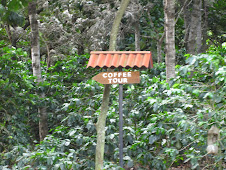
It’s no secret that
Did you know that coffee originated in
During the tour I discovered that the process of making coffee is extremely time consuming as well as a lot of hard work. First, the coffee plants are planted, and it take 3 years for the plant to grow and to begin producing the beans. Once a coffee plant has reached maturity it can produce beans for up to 10 to 20 years! Every year, just after the first rain of the season, amazingly, all of the coffee plants, or should I say trees because they are more like trees than plants, flower. They only flower for about three days and this is a signal from the plant that it is beginning to produce fruit. After the flowers disappear each plant begins producing a tiny little green fruit, that are about the size of small grapes (see the pictures). This is actually the coffee. After about a month, the fruit begins to ripen and turns bright red (see the pictures again). Once the fruit is ripe, it can then be harvested.
Each tree is picked by hand, which is an enormous task given the number of fruit on each plant, and only the red ripe fruit is selected. A coffee plant can be harvested several times during the year as the various fruit on the plant is produced and then ripens. Once the fruit is picked, it has to under go several different processes before it becomes the coffee we all know and love.
First, the fruit is opened and the red skin of the fruit is stripped away producing 2 tiny green coffee beans. The beans are then washed and begin the drying process, as it is necessary for the beans to be completely dry prior to the next stage of production.
At the coffee farms, there are these enormous concrete patios, the size of several football fields. The moist beans are then laid out to dry by the tens of thousands. The beans bake in the sun for 3 to 4 days and are constantly being turned over manually with rakes and shovels, to ensure that they are totally dry. So during the drying process there are thousands and thousands of coffee beans drying on these patios at any given time. Once the beans are completely dry they turn a very light brown color and are ready for distribution. The beans are then bagged in giant burlap sacks by hand and manually put onto trucks. This is extremely intensive labor as there are no machines to help with the bagging or forklifts to help with the loading.
Once the coffee has dried and been distributed, it is ready for roasting. Now this is where I found things to be really interesting, as prior to roasting all the beans are pretty much the same, with the exception of the different production qualities of the beans that I mentioned earlier.
So if all the beans are the same, what’s the difference between coffee and espresso? Is an espresso bean from a different kind of plant or a stronger version of the bean? How does that work?? Well I found out... It’s all in the roasting! For a light “breakfast” type of coffee, the beans are roasted at a very low temperature for 10-14 minutes. For your darker medium bodied coffee the beans are roasted from 14-18 minutes, and for a full bodied heavy “French” roast the beans are roasted at a high temperature for about 20 minutes. What about the espresso? Well, for an espresso roast, they blast the bean with super high temperatures for 24 or more minutes. And there you have it…coffee in a nutshell!
Well it was a really fun day, and it was awesome to learn all about coffee. We actually got to go into the roasting room and try 2 different types of the same bean, if that makes sense; one which was roasted for 14 min, and another that was an espresso roast and roasted for 24 minutes. It was really amazing in the distinction of taste with the espresso bean being a LOT stronger.
After our bean tasting experiment, our guide took us out onto a nice little patio shaded by the lush vegetation of the coffee farm where we were then served some 100% pure Arabica bean Guatemalan coffee. I think it was just about the best cup of coffee I’ve ever had.










No comments:
Post a Comment